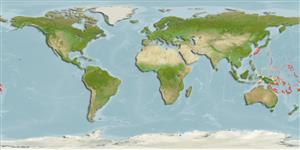Teleostei (teleosts) >
Eupercaria/misc (Various families in series Eupercaria) >
Lutjanidae (Snappers) > Apsilinae
Etymology: Paracaesio: Greek, para = the side of + Latin, caesium = bluish grey (Ref. 45335).
Environment: milieu / climate zone / depth range / distribution range
Ecology
Marine; bathydemersal; depth range 200 - 320 m (Ref. 9821), usually 200 - 250 m (Ref. 82366). Deep-water; 32°N - 22°S, 124°E - 177°W (Ref. 55)
Western Pacific: off the Ryukyu Islands to northeastern Australia and Samoa.
Length at first maturity / Size / Weight / Age
Maturity: Lm 40.0 range ? - ? cm
Max length : 50.0 cm SL male/unsexed; (Ref. 9821)
Dorsal spines (total): 10; Dorsal soft rays (total): 10; Anal spines: 3; Anal soft rays: 8. Eye large; snout short (shorter than eye diameter). Interorbital space slightly convex. Lower jaw protruding slightly. Scale rows on back parallel to lateral line. Pectoral fins long, reaching level of anus. Back and upper sides light brown, silvery on lower sides and belly; five brown vertical bars on the upper side; the fins are gray to whitish; the margin of the dorsal fin and most of the caudal fin yellow.
Adults are found on the continental shelf and continental slope (Ref. 75154).
Life cycle and mating behavior
Maturities | Reproduction | Spawnings | Egg(s) | Fecundities | Larvae
Allen, G.R., 1985. FAO Species Catalogue. Vol. 6. Snappers of the world. An annotated and illustrated catalogue of lutjanid species known to date. FAO Fish. Synop. 125(6):208 p. Rome: FAO. (Ref. 55)
IUCN Red List Status (Ref. 130435)
Threat to humans
Harmless
Human uses
Fisheries: subsistence fisheries
Tools
Special reports
Download XML
Internet sources
Estimates based on models
Preferred temperature (Ref.
123201): 18.3 - 21.1, mean 18.9 °C (based on 7 cells).
Phylogenetic diversity index (Ref.
82804): PD
50 = 0.5039 [Uniqueness, from 0.5 = low to 2.0 = high].
Bayesian length-weight: a=0.03388 (0.01545 - 0.07431), b=2.88 (2.68 - 3.08), in cm total length, based on LWR estimates for this species & (Sub)family-body (Ref.
93245).
Trophic level (Ref.
69278): 4.0 ±0.66 se; based on food items.
Generation time: 5.5 ( na - na) years. Estimated as median ln(3)/K based on 1
growth studies.
Resilience (Ref.
120179): Medium, minimum population doubling time 1.4 - 4.4 years (Preliminary K or Fecundity.).
Fishing Vulnerability (Ref.
59153): Moderate to high vulnerability (50 of 100).
Nutrients (Ref.
124155): Calcium = 21.2 [10.2, 51.2] mg/100g; Iron = 0.38 [0.14, 0.88] mg/100g; Protein = 17.4 [15.4, 19.3] %; Omega3 = 0.297 [0.134, 0.609] g/100g; Selenium = 15.8 [6.7, 37.8] μg/100g; VitaminA = 8.28 [1.38, 57.57] μg/100g; Zinc = 0.325 [0.204, 0.511] mg/100g (wet weight);
